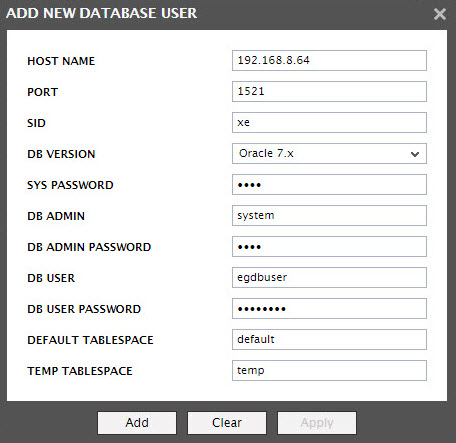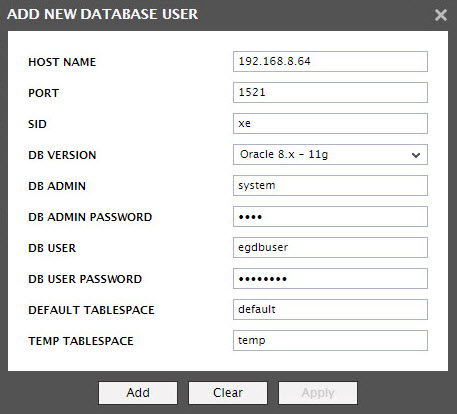Configuring Tests for an Oracle Database Server
As already mentioned, eG agents can collect a variety of statistics regarding Oracle database servers. To monitor an Oracle database server, eG Enterprise requires that a special database user account be created in each Oracle database instance to be monitored. Figure 1 depicts the parameters to be configured for the Oracle Database File Status test. While configuring the Oracle tests, a Configure a database user button ( ) is provided alongside the user parameter.
) is provided alongside the user parameter.

Figure 1 : Parameters to be configured for Oracle Database File Status test
Clicking on the  button will take you to the page shown by Figure 2. In Figure 2, the host name, port number and the side of the Oracle server to be configured appear in the corresponding location and cannot be changed. So, proceed to select a db version. If the user chooses to monitor Oracle 7.x, it is mandatory to provide the password of the SYS user in the SYS PASSWORD text box. To add a new user, specify the database administrator’s login and password. While creating a new user, the account has to be associated with a default tablespace where the user’s data is hosted and a temporary tablespace which is used for buffering, sorting etc. The identities of the default and temporary tablespaces have to be input in Figure 2.
button will take you to the page shown by Figure 2. In Figure 2, the host name, port number and the side of the Oracle server to be configured appear in the corresponding location and cannot be changed. So, proceed to select a db version. If the user chooses to monitor Oracle 7.x, it is mandatory to provide the password of the SYS user in the SYS PASSWORD text box. To add a new user, specify the database administrator’s login and password. While creating a new user, the account has to be associated with a default tablespace where the user’s data is hosted and a temporary tablespace which is used for buffering, sorting etc. The identities of the default and temporary tablespaces have to be input in Figure 2.

Figure 2 : Configuring a database user for an Oracle database server v7.x
If you choose Oracle 8.x - 11g as the db version (see Figure 3, it implies that the Oracle database server being monitored is of a version between 8.x and 11g. In this case, you do not need a sys password for creating a new database user. Just provide the db admin and db password and then proceed to specify the credentials of the new database user against the db user and db user password text boxes. Then, as before, specify the identities of the default and temporary tablespaces and click Add to add the new database user.

Figure 3 : Configuring a database user for an Oracle database server v8.x to 11g
Choosing Oracle 12c as the db version requires that you pick the type of db connection (see ). The db connecTion can either be PDB or CDB, depending upon the archicture of the Oracle 12c server. On the surface, a CDB or a Container database, may seem very similar to a conventional Oracle database, as it contains most of the working parts you will be already familiar with (controlfiles, datafiles, undo, tempfiles, redo logs etc.). It also houses the data dictionary for those objects that are owned by the root container and those that are visible to all PDBs.
Since the CDB contains most of the working parts for the database, the PDB or the Pluggable Database only needs to contain information specific to itself. It does not need to worry about controlfiles, redo logs and undo etc. Instead it is just made up of datafiles and tempfiles to handle it's own objects. This includes it's own data dictionary, containing information about only those objects that are specific to the PDB.
Once the db connection is set, just provide the db admin and db password and then proceed to specify the credentials of the new database user against the db user and db user password text boxes. Then, as before, specify the identities of the default and temporary tablespaces and click Add to add the new database user.
